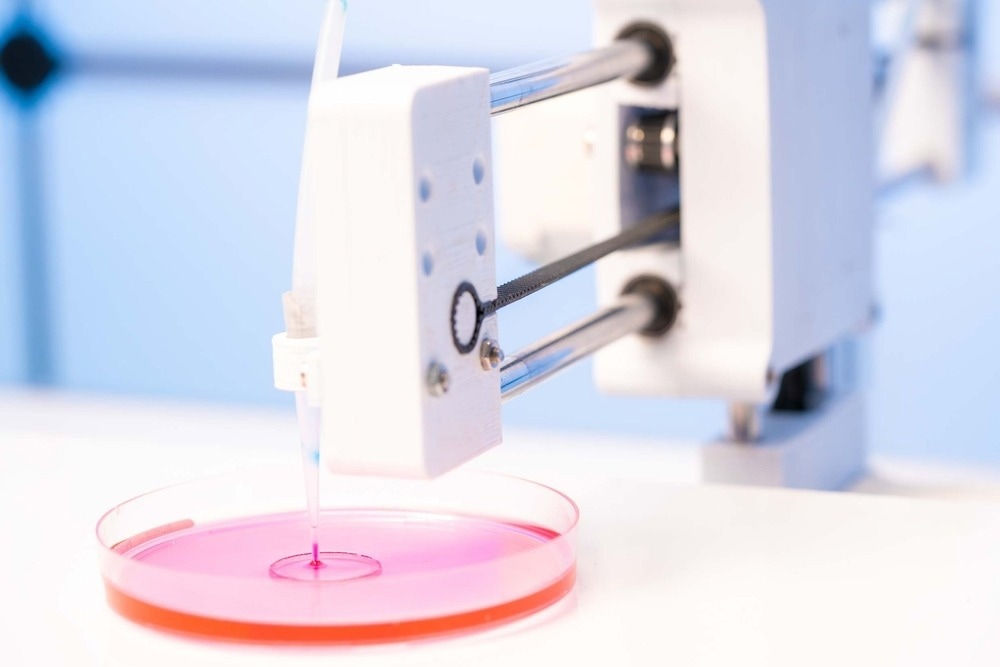A new paper in the journal Bioprinting has explored the influence of cell density on the rheological properties of a proprietary silk fibroin-gelatin bioink. The research has been conducted by scientists from the Indian Institute of Technology Delhi in India.

Study: Effect of varying cell densities on the rheological properties of the bioink Image Credit: luchschenF/Shutterstock.com
Rheology in Bioinks
Bioinks are increasingly used in 3D bioprinting, which is an advanced fabrication technology used in key biomedical fields such as tissue engineering. 3D bioprinting produces tissues with complex architecture via a layer-by-layer deposition process. There is a wide range of complexities in these processes including material choice, cell type selection, technology choice, design, and physical and rheological categorization of biomaterials.
Extrusion-based 3D bioprinting techniques are widely employed in the field due to their versatility in material type and properties, enabling the fabrication of complex tissues with enhanced cell viability and density. Key challenges in bioink design include providing insights into the mechanical and rheological characteristics of final printed three-dimensional constructs with high-resolution cellular deposition.
The bioink’s rheology profile plays a key role in determining its flow, deformation, shape fidelity, and printability. Moreover, this influences the properties of the final products and the cell proliferation and differentiation rate in printed constructs. Rheological characterization of an extruded bioink is intrinsically linked with the bioactivity and mechanical stability of products post-extrusion.
Current Research Perspectives
Rheological characteristics such as viscosity, time-dependent viscoelastic properties, time-independent viscoelastic properties, yield stress, and gelation kinetics all play a key role, and thus have been the focus of research in recent years.
A study by Mouser et al. investigated the role of yield stress by using different concentrations of gellan gum and gelatin methacrylolyl in bioinks. Chen et al. demonstrated the benefits of increasing bioink shear-thinning behavior using a bioink that combines gellan gum, alginate, and bioactive molecules. Appropriate viscosity and yield stress play a key role in producing homogenous cell mixtures in bioinks.
Other studies have highlighted the crucial importance of viscoelastic properties. These properties protect cells against construct instability and shear stresses. Furthermore, research has demonstrated the optimization of gelation time, revealing its key role as a bioink bioprinting parameter for optimizing printability and stable hydrogel network formation.
Researchers have utilized several computational and experimental approaches to demonstrate how rheological characteristics and printability are correlated. Mathematical models can evaluate operational parameters such as printing pressure, extrusion velocity, and nozzle speed based on hydrogel rheology. This ensures cell viability both during the 3D bioprinting process and afterward.
The Research
The authors have explored the influence of cell density on the rheological properties of a silk fibroin-gelatin bioink. The proprietary bioink used by the authors is the result of several years of research wherein the ink underwent continuous printability assessment and rheological optimization. The bioink’s viability has been evaluated on several cell types, such as human fibroblasts, stem cells, and articular chondrocytes.
Additional enzymatic crosslinking using mushroom tyrosinase is employed in the bioink to enhance its mechanical properties. Enhanced cell viability and printability resolution are achieved by multi-fold increases in viscosity drop and modulus characteristics.
The paper’s authors have noted that similar printability and rheological studies have been conducted which provide pertinent information on modulus properties and viscosity but ignore the influence of interaction by the cellular component. Furthermore, the influence of varying cell densities on the rheological behavior of 3D printed bioinks has not been reported thus far.
0.1, 0.5, 1, and 2 million cells/ml densities were prepared and analyzed. These cells were immortalized mouse BMSC lines, which were engineered to express TVA receptors. Genes were incorporated using avian retroviruses.
Viscoelastic properties, gelation kinetics, and flow behaviors of both crosslinked and non-crosslinked bioinks were evaluated in the research. Preliminary printability analysis was performed to evaluate the suitable cell density for bioprinting.
Study Findings
Compared to mushroom tyrosinase enzymatically crosslinked samples, non-crosslinked bioinks possess inconsistent shear-thinning profiles and a low storage modulus. Cell incorporation decreases loss factor, shear viscosity, and storage modulus but increases gelation time. Cell densities of 2 million/ml negatively impact cell printability, whereas 1 million cells/ml improves the coherence of printed constructs.
Therefore, a cell density of 1 million cells/ml encapsulated within the bioink was revealed to provide optimal printability and rheological characteristics. This produces printed constructs with enhanced stability and cell viability, proliferation, and differentiation potentials.
Further work in this area should be conducted on different cell types and their influence on bioink printability and rheological profiles. This will generate more detailed insights into the fundamental underlying mechanisms which govern the rheology of bioink during extrusion-based 3D bioprinting methods.
More from AZoM: A Closer Look at Semiconductor Test Equipment
Further Reading
Majumder, N, Mishra, A & Ghosh, S (2022) Effect of varying cell densities on the rheological properties of the bioink Bioprinting e00241 [online, pre-proof] sciencedirect.com. Available at: https://www.sciencedirect.com/science/article/pii/S2405886622000513?via%3Dihub
Disclaimer: The views expressed here are those of the author expressed in their private capacity and do not necessarily represent the views of AZoM.com Limited T/A AZoNetwork the owner and operator of this website. This disclaimer forms part of the Terms and conditions of use of this website.